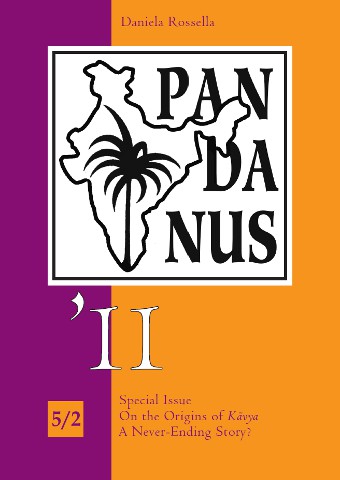Pandanus ’11: Nature in Literature, Art, Myth and Ritual.
Volume 5, No. 2 (2011)
Special Issue
Daniela Rossella
On the Origins of Kavya
A Never-Ending Story?
E-mail: ghezziem@tin.it
Editor-in-chief: Jaroslav Vacek
Deputy Editor: Martin Hříbek
Members of the Editorial Board:
Giuliano Boccali (University of Milano, Italy)
Alexander Dubianski (University of Moscow, Russia)
Daniele Feller (University of Lausanne, Switzerland)
Adalbert J. Gail (Freie Universität, Berlin, Germany)
Oldřich Král (Charles University in Prague, Czech Republic)
Dagmar Marková (Oriental Institute, Academy of Sciences of the Czech Republic)
Cinzia Pieruccini (University of Milano, Italy)
Tiziana Pontillo (University of Cagliari, Italy)
Chettiarthodi Rajendran (University of Calicut, Kerala, India)
Danuta Stasik (University of Warsaw, Poland)
Lidia Sudyka (Jagiellonian University of Krakow, Poland)
Anna Trynkowska (University of Warsaw, Poland)
Eva Wilden (EFEO, Paris, France)
Gyula Wojtilla (University of Szeged, Hungary)
Reviewed by Prof. Anna Trynkowska (University of Warsaw, Poland)
Prof. Gyula Wojtilla (University of Szeged, Hungary)
and Dr. Mario Russo, PhD. at the University of Pisa
English correction: Dr. Mark Corner, HUB University, Brussels
Institute of South and Central Asian Studies, Seminar of Indian Studies
Philosophical Faculty, Charles University in Prague
Celetná 20, 116 42 Praha 1, Czech Republic
http://iu.ff.cuni.cz
Publisher: Stanislav Juhaňák - TRITON
http://www.triton-books.cz
First edition, Praha (Prague) 2010
ISSN 1802-7997
(Registration number of MK ČR) E 17677
The publication of this journal was financially supported by the Ministry of Education of the Czech Republic as a part of the Research Project No. MSM0021620824, “The Foundations of Modern World in the Mirror of Literature and Philosophy”, a project of the Faculty of Philosophy, Charles University in Prague.
Summary
The aim of my essay is to suggest – through a systematic analysis of the Theragāthās – that exactly in these ancient Buddhist compositions (universally recognised as the most eminent precedent of the kāvya) it is possible to trace the true origins of one of the most famous and long-lived literary traditions of India, i.e. the “literature as a form of art”.
Therefore, I intend to show that (contrary to what has already been maintained) the Buddhist monk-poets laid the bases for a literary genre destined to have an immense fortune to this day; the supposed profane origin of the kāvya is also based on the conjecture that the monks of the Gāthās were inspired, specifically into the so-called “rain-poems”, by a popular production with a secular and, above all, amorous tone. Unfortunately, not a single syllable of this production has been handed down and we cannot know if “the old people” were devoted to singing only and exclusively the love and not (also, at least) themes with a religious, magic, heroic tone.
My hypothesis also implies that the aesthetic experience of the inner peace (śānti-rasa) should be placed at the origin of kāvya, the rasa that, in the decisive reflection of Abhinavagupta, will be considered as the most important. Moreover, only with the exception (even if in part!) of the Hāla's Sattasaī, all first kāvya texts reached to the present are not characterized by the rasa of love (śṛṅgāra-rasa), almost considered “the symbol of kāvya”, due also to the supposed secular origins of the “literature as a form of art”. In fact, the Bṛhatkathā, in Somadeva’s words, proclaims the wonder (adbhuta-rasa) before the sublime divine game of creation; Aśvaghoṣa, in his mahākavyas, openly maintains that he has “told the Truth under the pretext of art”; and the Rāmāyaṇa, the Ādikāvya, whose style can be set on the boundary between itihāsa and kāvya, is defined by Vālmīki also ārṣa, that is “belonging to the tradition of ṛṣis”, a definition implying both the eminence of the poetic values and the sacredness connected to the dharmic aim of the work (it is necessary to remember that the core of the Rāmāyaṇa had had to start developing around the sixth century B.C.E, when had to start, as K.R. Norman maintains, the draft of the Stanzas of the Monks and of the Nuns).
Then, the theater, whose first evidences are represented by Aśvaghoṣa's fragments, claims a divine origin and defines itself the “Fifth Veda” as well, i.e., essentially, an instrument of moral elevation and Salvation for those who could not approach the texts of the Śruti. Finally, if we think that the rasa, ātman of the kāvya, aims at evoking a gleam, even if momentary, of the mokṣa (or of the nirvāṇa) it seems a bit arduous to define the “literature as a form of art” as “profane” and “secular”.
Moreover, in this brief essay I examine two fundamental tenets of kāvya: the (rhetorical) ‘art of suggesting’ (by means of śleṣa and dhvani) and the presence of Nature – both of them are perceptibly present in the Theragāthās, and they are in their turn aimed at evoking (also with proselytizing purposes) the quenched condition of the Buddhist monks.
back to publications list | buy Pandanus online | 
back to publications list | buy Pandanus online |